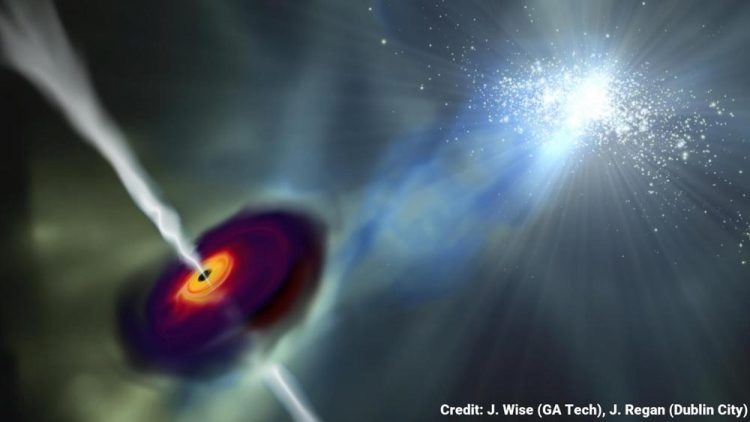New model explains the formation of supermassive black holes in the very early universe

An artist impression depicting the formation of a supermassive black hole with a mass of tens of thousands of solar masses in close proximity to a protogalaxy. The primordial black hole is surrounded by an accretion disk and it has launched two symmetrical jets, whereas a large cluster of bright massive stars can be seen in the protogalaxy. The picture depicts the simulation at redshift z=24 corresponding to about 140 million years after the Big Bang. Credit: J. Wise (Georgia Tech) & J. Regan (Dublin City)
The observations of extremely massive black holes in the very early Universe are somewhat surprising, since it is not straightforward to grow the mass of black hole from tens up to billions of solar masses in the limited time available, says Associate Professor Peter Johansson from University of Helsinki, who has developed a new simulation model to describe in more detail the formation of supermassive black holes in the early Universe.
A black hole grows most effectively through the accretion of gas, but when the gas hurls towards the black hole it heats up strongly due to friction forces and the strong gravitational field. The resulting hot gas radiates strongly and some fraction of the radiation couples with the infalling gas exerting strong radiation pressure, preventing further gas infall.
Thus black holes cannot be force-fed, as too much accretion results in a strong burst of radiation that pushes back the infalling gas.
When very large gas clouds collapse directly to seed supermassive black holes
During the last years an alternative model for the formation of supermassive black holes in the early Universe has been developed. In this so called “Direct collapse black hole model” very large gas clouds with masses of 10 000 -100 000 solar masses collapse directly to seed supermassive black holes.
A prerequisite for this direct collapse is that the gas cooling is very inefficient, as otherwise the collapsing gas cloud would fragment and result in star formation. In the very early Universe the only way of cooling gas at low temperatures was by emission from molecular hydrogen.
An article titled “Rapid formation of massive black holes in close proximity to embryonic protogalaxies” published in the prestigious Nature Astronomy journal on March 13th, 2017, shows for the first time that the near simultaneous formation of two galaxies can lead to a situation in which the radiation from the first galaxy can destroy the molecular hydrogen in the second galaxy just at the right time.
– In this way a massive direct collapse black hole seed can form in the second galaxy, which can evolve rather quickly to a billion solar mass black hole by the time they are observed in the Universe, Peter Johansson says.
The new simulation model describing the formation of supermassive black holes in the early Universe in more detail was developed at the University of Helsinki by Peter Johansson in close collaboration with Irish and American researchers.
###
The main author of the article, Dr. John Regan (Dublin City University) was formerly a postdoctoral researcher at the University of Helsinki
The research article published on the Nature Astronomy website, http://www.
Image:
An artist impression depicting the formation of a supermassive black hole with a mass of tens of thousands of solar masses in close proximity to a protogalaxy. The primordial black hole is surrounded by an accretion disk and it has launched two symmetrical jets, whereas a large cluster of bright massive stars can be seen in the protogalaxy. The picture depicts the simulation at redshift z=24 corresponding to about 140 million years after the Big Bang. Credit: J. Wise (Georgia Tech) & J. Regan (Dublin City).
Contact information:
Peter Johansson, University of Helsinki, peter.johansson@helsinki.fi, +358 50 318 3930
Minna Meriläinen-Tenhu, Press Officer, University of Helsinki, @MinnaMeriTenhu, +358 50 415 0316
Media Contact
All latest news from the category: Physics and Astronomy
This area deals with the fundamental laws and building blocks of nature and how they interact, the properties and the behavior of matter, and research into space and time and their structures.
innovations-report provides in-depth reports and articles on subjects such as astrophysics, laser technologies, nuclear, quantum, particle and solid-state physics, nanotechnologies, planetary research and findings (Mars, Venus) and developments related to the Hubble Telescope.
Newest articles

NASA: Mystery of life’s handedness deepens
The mystery of why life uses molecules with specific orientations has deepened with a NASA-funded discovery that RNA — a key molecule thought to have potentially held the instructions for…

What are the effects of historic lithium mining on water quality?
Study reveals low levels of common contaminants but high levels of other elements in waters associated with an abandoned lithium mine. Lithium ore and mining waste from a historic lithium…

Quantum-inspired design boosts efficiency of heat-to-electricity conversion
Rice engineers take unconventional route to improving thermophotovoltaic systems. Researchers at Rice University have found a new way to improve a key element of thermophotovoltaic (TPV) systems, which convert heat…



